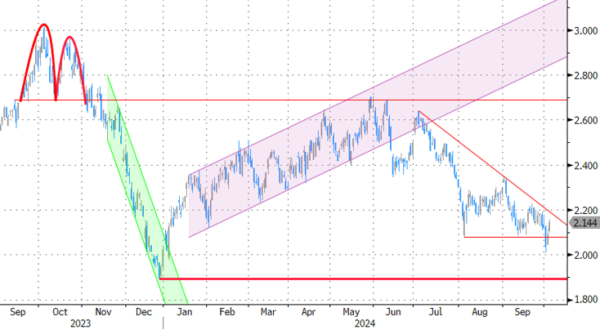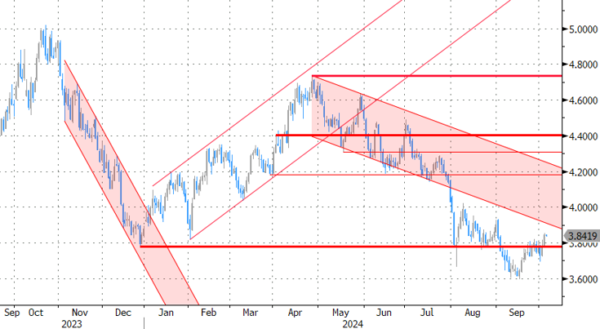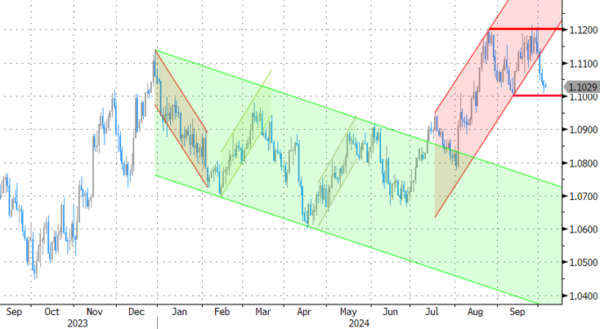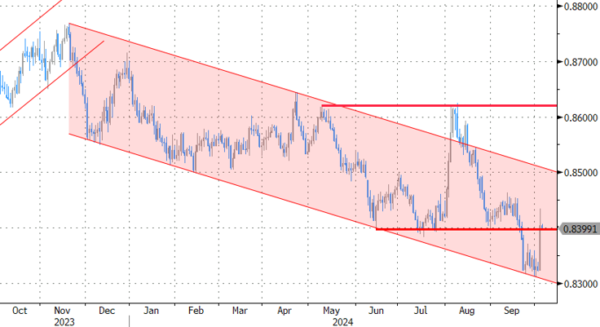Markets
This week’s US data was supposed to be key input for markets to make up their mind on the amount of Fed easing in November. Data released earlier this week (JOLTS, ISMs, jobless claims, ADP), except for a poor manufacturing ISM were not bad, but also not strong enough to already reject the option of another 50 bps step. Yesterday’s services ISM serves as an illustration. The overall report was much stronger than expected and suggests a solid rebound in services activity. The headline index jumped from 51.5 to 54.9, the best level since February last year. Details showed strong activity (59.9!) and new orders 59.4. Corporates also expect accelerating price growth (prices paid 59.4 from 57.3). However, employment falling back in contraction territory (48.1 from 50.2) was an important exception to the rule. US yields added between 7.5 bps (5-y) and 4.8 bps (30-y), but an important part of this rise already occurred before the ISM release. With two subsequent 25 bps ECB cuts in October and December discounted, the downside in European yields also became better protected. German yields added between 5.3 bps (5-y) and 4.1 bps (2-y). Good news didn’t help equities as geopolitical tensions linger (S&P 500 -0.14%). Brent oil jumped from sub-$75 p/b levels to the high $ 77 area. USD gains were again modest, maybe slightly disappointing (DXY from 101.64 to 101.98, USD/JPY from 146.5 to 146.9; EUR/USD 1.1045 from 1.103). Sterling fell off a cliff with EUR/GBP jumping from the 0.833 to close at 0.8405, but this was the result from BoE governor Bailey signaling potentially more activist easing.
The US payrolls will take center stage today. Consensus expects stable September job growth (150k from 142k). The unemployment rate is also expected unchanged at 4.2%. Average hourly earnings are seen at 0.3% M/M and 3.8% Y/Y. We assess the market positioning to be quite neutral with expectations for a 50 bps November step scaled back to 35%. The 2-y yield also is in the middle of a potential ST consolidation pattern between 3.50% and 3.90%. Aside from job growth, the unemployment rate might gain some importance as it is at what the Fed sees as a neutral level. A higher unemployment rate might rekindle expectations for a 50 bps step. Even so, plenty of data/news will come between now and the November 7 meeting. Recent action suggest sustained USD gains aren’t easy even if data and/or interest rates are supportive. For EUR/USD 1.1002 (September low) is a first interesting technical reference.
News & Views
Longshoremen at US east and gulf coast ports will resume work after the dockworkers’ union reached an agreement with their employers yesterday. The strike started on Tuesday and threatened to cost the US economy several billions a day through disruption of global supply chains, halted imports of fresh foods, pharmaceuticals and other consumer goods. The ports are estimated to handle a combined 25% of total US annual trade. Workers laid down activity over wages and concerns on the impact of automation on their jobs after the current labor contract expired on Tuesday. They now agreed to extend it until January 15 after the union accepted an offer that would increase wages 61.5% over the new six-year contract while insisting on other language to “protect [them] from automation”. The three-day strike is estimated to take around 12 days to fully clear.
The National Bank of Poland (NBP) earlier this week kept policy rates unchanged at 5.75%. NBP has been holding the same, hawkish line for several months now: high rates are necessary to counter inflation and contain inflation expectations. Inflation earlier this year returned to the central bank target but recently began to rise again as the government rolled back energy price subsidies. It is this fiscal policy uncertainty combined with sticky core inflation (>3.5%) that’s been guiding the NBP. That narrative still held in the official policy statement. At yesterday’s presser, though, governor Glapinski turned more dovish again. As recent as July he said rate cuts could only happen in 2026 before pivoting in the subsequent weeks to “Q2 of next year”. In September he did say that one rate cut doesn’t necessarily signal an entire easing cycle. Yesterday Glapinski noted that “a cycle” of cuts could happen “in March, April, or earlier”. It all boils down to the March meeting after which, if new projections show inflation stabilizing and then declining, the discussion at least may start. Most CE currencies lost ground yesterday with the zloty and the forint (EUR/HUF >400) underperforming. EUR/PLN closed north of 4.3 for the first time since mid-August. Polish swap yields deviated from peers through front-end outperformance.
Graphs
GE 10y yield
The ECB cut policy rates by 25 bps in June and in September. Stubborn inflation (core, services) make a follow-up move less evident in October, but very weak PMI’s and soft Lagarde comments hang in the balance. Disappointing US and unconvincing-to-outright-weak EMU activity data dragged the long end of the curve down with the 2023 low at 1.89% as key support.
US 10y yield
The Fed kicked off its easing cycle with a 50 bps move. It is headed towards a neutral stance now that inflation and employment risks are in balance. Conservative SEP unemployment forecasts risk being caught up by reality and with it the dot plot (50 bps more cuts in 2024). We hold our call for two more 50 bps cuts this year. Pressure on the front of the curve and weakening eco data keeps the long end in the defensive for now as well.
EUR/USD
EUR/USD moved above the 1.09 resistance area as the dollar lost interest rate support at stealth pace. US recession risks and bets on fast and large rate cuts trumped traditional safe haven flows into USD. An ailing euro(pean economy) partially offset some of the general USD weakness. EUR/USD’s dollar-driven rise bumped into 1.12 resistance. The 1.1002 September lows is first important support.
EUR/GBP
The BoE delivered a hawkish cut in August. Policy restrictiveness was indicated to be further unwound gradually on a pace determined by a broad range of data. The economic picture between the UK and Europe also was increasingly diverging to the benefit of sterling, pulling EUR/GBP below 0.84 support. Dovish comments by BoE Bailey ended by default GBP-strength.
















